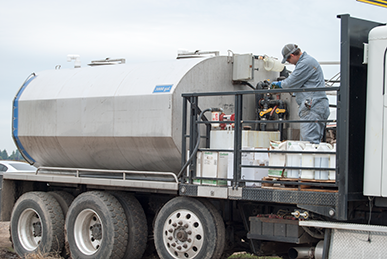How do I comply with WPS when working with a commercial pesticide handler employer?
This FAQ addresses the WPS requirements for agricultural employers when they hire a commercial pesticide handler employer (CPHE) (e.g., custom applicators) to make pesticide applications on their agricultural establishment. There are additional responsibilities for WPS compliance for agricultural employers who employ their own workers and handlers.

Employer Information Exchange
Whenever a commercial pesticide handler will apply a pesticide on your agricultural establishment, the CPHE must provide you with certain information. The purpose of this exchange is to give you the information you need to comply with WPS. After all, you need to inform workers about treated areas with restricted entry, and you need to display the appropriate pesticide application information (record) and accompanying Safety Data Sheets (SDSs).
View More
View Less
Information You Must Provide the Commercial Pesticide Handler Employer
Before a commercial pesticide handler (the employee of the CPHE) enters an agricultural establishment, you must inform the CPHE about treated areas and any restricted-entry intervals on the establishment, and the CPHE must provide that information to the commercial pesticide handler. The CPHE must obtain this information so it can be communicated to their handler employees.
You must provide to the CPHE:
- The specific location and description of any treated areas on the agricultural establishment under a restricted-entry interval that the commercial pesticide handler may be in (or walk within 1/4 mile of), and
- Any restrictions on entering those areas.
Information a Commercial Pesticide Handler Employer Must Provide to You
To allow you to inform workers on the establishment about a pesticide application that is, or will be performed, the CPHE (for-hire/custom applicator) must inform you of the following:
- Specific location and description of the area(s) on the agricultural establishment that are to be treated with a pesticide,
- Date of the application, and estimated start and end times of the application,
- Product name, EPA registration number, and active ingredient(s),
- Restricted-entry interval for the pesticide,
- Whether the agricultural employer is required to notify workers by posting, oral notification or both, and
- Any other specific requirements on the pesticide labeling concerning protection of workers and other persons during or after application.
What if the information changes?
The CPHE must provide you with updated information PRIOR to the application when there are any changes to:
- The location to be treated,
- the REI,
- the method of notification,
- the labeling requirements to protect workers/other persons, or the start time which will cause it to be earlier than estimated.
Changes to the estimated application end time of less than one hour do not need to be reported to you.
If the product information changes or there are other changes to the date, start time, or end time, the CPHE must provide the updated information to you within 2 hours after completing the application.
Posting of Treated Sites, Oral Warnings, and Displaying Application and Hazard Information
Based on the information provided by the CPHE, you must post the treated area with designated WPS warning signs and/or provide oral warnings to your workers. The purpose of this notification is to inform workers of treated areas under an REI, so they know to keep out of those treated areas.
Additionally, you must display the pesticide application information (record) and SDS(s) for the pesticide application conducted by the CPHE.

Application Exclusion Zone
It is your responsibility to keep workers and others out of the treated area and the application exclusion zone (AEZ) during pesticide applications.
You may not allow a pesticide to be applied, or a suspended application to be resumed, while anyone on the establishment is in the treated area or within the AEZ.
View More
View Less
Suspending Applications
Effective January 2, 2018, there is a separate AEZ requirement that applies to the pesticide handler making a pesticide application (the commercial handler in this situation) that requires the handler to temporarily suspend the application if any worker or other person (other than an appropriately trained and equipped handler involved with the application) is in the:
- AEZ for outdoor production applications, or
- Area required to be free of workers or others during enclosed space production applications.
The AEZ may extend beyond the boundaries of your establishment.
It is the CPHE and the commercial handler's responsibility to ensure that no pesticide is applied in a manner that contacts, directly or through drift, any worker or other person, other than an appropriately trained and equipped handler(s) involved in the application. This responsibility is a label requirement, shared by everyone involved in the application.
Learn more:

Regulatory Guidance
Browse brief guides about protections for workers and handlers, the AEZ, posting, PPE, exemptions, training, respirators, and more, in English and Spanish.
